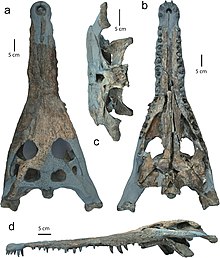| Penghusuchus Temporal range: Late Miocene,
| |
|---|---|

| |
| Skull | |
| Scientific classification | |
| Domain: | Eukaryota |
| Kingdom: | Animalia |
| Phylum: | Chordata |
| Class: | Reptilia |
| Clade: | Archosauromorpha |
| Clade: | Archosauriformes |
| Order: | Crocodilia |
| Family: | Gavialidae |
| Genus: | †Penghusuchus Shan et al., 2009 |
| Type species | |
| †Penghusuchus pani Shan et al., 2009
| |
Penghusuchus is an extinct genus of gavialid crocodylian. It is known from a skeleton found in Middle to Upper Miocene rocks of Penghu Island, off Taiwan. The taxon was described in 2009 by Shan and colleagues; the type species is P. pani.[2] It may be related to two other fossil Asian gavialids: Toyotamaphimeia machikanensis of Japan and Hanyusuchus sinensis of South China.[3] It was a medium-sized gavialid with an estimated total length of 4.5 metres (15 ft).[4]
- ^ Rio, Jonathan P.; Mannion, Philip D. (6 September 2021). "Phylogenetic analysis of a new morphological dataset elucidates the evolutionary history of Crocodylia and resolves the long-standing gharial problem". PeerJ. 9: e12094. doi:10.7717/peerj.12094. PMC 8428266. PMID 34567843.
- ^ Shan, Hsi-yin; Wu, Xiao-chun; Cheng, Yen-nien; Sato, Tamaki (2009). "A new tomistomine (Crocodylia) from the Miocene of Taiwan". Canadian Journal of Earth Sciences. 46 (7): 529–555. Bibcode:2009CaJES..46..529S. doi:10.1139/E09-036.
- ^ Iijima, Masaya; Qiao, Yu; Lin, Wenbin; Peng, Youjie; Yoneda, Minoru; Liu, Jun (2022-03-09). "An intermediate crocodylian linking two extant gharials from the Bronze Age of China and its human-induced extinction". Proceedings of the Royal Society B: Biological Sciences. 289 (1970). doi:10.1098/rspb.2022.0085. ISSN 0962-8452. PMC 8905159.
- ^ Iijima, M.; Kubo, T. (2020). "Vertebrae-Based Body Length Estimation in Crocodylians and Its Implication for Sexual Maturity and the Maximum Sizes". Integrative Organismal Biology. 2 (1). obaa042. doi:10.1093/iob/obaa042. PMC 7891683.